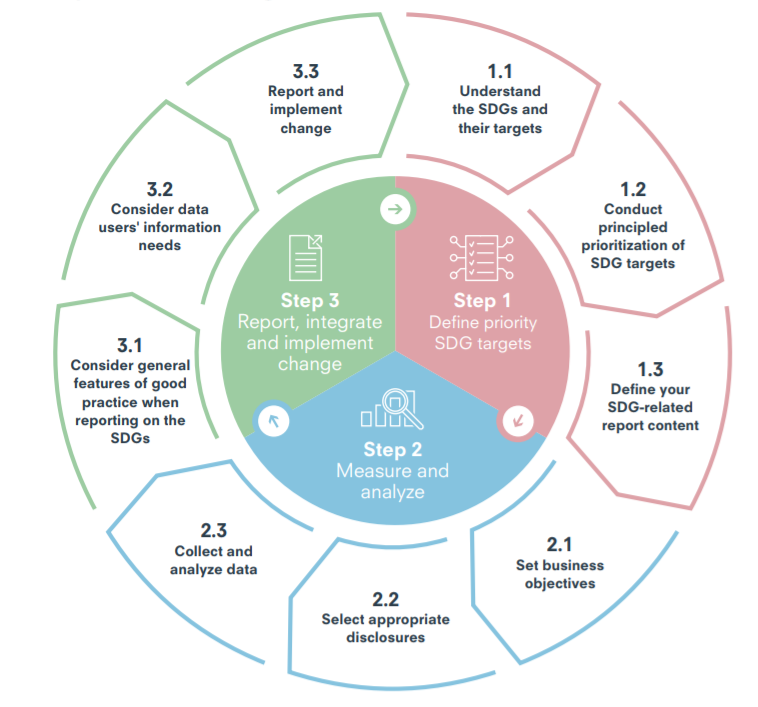In early August, the initiatives GRI (Global Reporting Initiative) and UNGC (United Nations Global Compact), with the support of Shift and PWC, published a practical guide in order to support companies in targeting their impact on the SDGs (Sustainable Development Goals), to measure and to integrate it more adequately into the corporate (sustainability) reporting.
Sustainability reporting enables companies the measurement and analysis of pre-existing sustainability goals and measures, increases the entrepreneurial ability to reflect and ensures sufficient transparency of sustainability performance vis-à-vis central stakeholder groups (e. g. Fifka, 2013, p. 126f.). An adequate integration of the Sustainable Development Goals into this process also enables the analytical measurement of negative and positive effects within the value chain. With serious and consistent implementation in order to minimize the negative as well as maximize the positive effects, companies can make a decisive contribution to the sustainable development and thus to the Agenda 2030.
The guide isn’t a new framework. Rather, it should be considered as a complementary tool that helps companies identify, prioritize, measure, and subsequently report on the Sustainable Development Goals in the context of the core business. The guide also aims at helpingo guide the current trend of simply declaring SDGs and mapping them with corporate activities towards a proactive and inclusive approach (see GRI, 2018).
The guide to integrating the Sustainable Development Goals into sustainability reporting – an overview
- The guide includes 30 pages (incl. appendix)
- Written in English language (available here)
- Completes the ‘Action Platform on Reporting on the SDGs’ toolbox (other documents in this set include, for example, an analysis of the goals and targets, or the focus on investor-specific needs in SDG reporting).
- Includes three implementation steps, each with three subitems in the form of a circular process (see Fig. 1)
Fig. 1: Implementation steps to integrating the SDGs into corporate sustainability reporting (source: Integrating the SDGs into corporate reporting: a practical guide, p. 5)
Step 1 – Define priority SDG targets
Based on the implementation principles of the SDG compass (see, for example, the DFGE blog from 28th March 2018 or the SDG compass), the first step is to understand and localize those Sustainable Development Goals and specific targets which are related to the core business and the value chain. What is key here is to prioritized. With the following approaches a company can approximate its priorities. Either the company exposes significant company-specific risks to society and the environment in connection with the SDGs, or the appropriate goals are filtered to which a company has or can have a beneficial effect due to its own products, services or investments. In other words, an opportunity / risk analysis in the context of topic-specific trends as well as in the context of entrepreneurial strengths and weaknesses helps localize and prioritize the applicable Sustainable Development Goals and the respective targets as well as to increase the capacity for innovation. The stakeholder consultation and involvement then help evaluate the impact of SDG-specific topics on their decisions. As a result, a sufficient basis for relevant SDG content of the sustainability report can be created (see Integrating the SDGs into corporate reporting: a practical guide, p. 10ff.).
Step 2 – Measure and analyse
Based on the results of the first step, companies can set up appropriate strategies and formulate goals to achieve the filtered Sustainable Development Goals (and their targets) in a company-specific context. Here, the following aspects are important (see Integrating the SDGs into corporate reporting: a practical guide, p. 19ff.).
- Set goals to reach or contribute to the filtered SDG targets
- Positive effects should be maximized (proactive implementation)
- Identify Key Performance Indicators
- Choose qualitative and quantitative topics to disclose
- Data collection and analysis as the declaratory basis of reporting
Step 3 – Report, integrate and implement change
The contents of the third step are primarily focused on handling the reporting on the SDGs, i. e. on the visualization and transparency of the previous process steps. Some of the contents of the guide are listed below (see Integrating the SDGs into corporate reporting: a practical guide, p. 23ff.):
- Orientation of reporting on SDG content to frameworks
- Presentation of local aspects (e. g. social developments at respective locations)
- Communication of the SDG content via other channels (e. g. social media, website, …)
- Meet the growing need for information of stakeholders in the SDG-specific context (e. g. governments, investors, NGOs)
- Assessment of the set goals
- SDG reporting as a basis for future decision-making
Support by the DFGE
The DFGE supports you regarding the SDGs, their strategic integration into the core business as well as in all related processes and steps. In addition, we make your efforts transparent, for example through a GRI report. Contact us for your Sustainability Intelligence at or +49.8192.99733-20.










